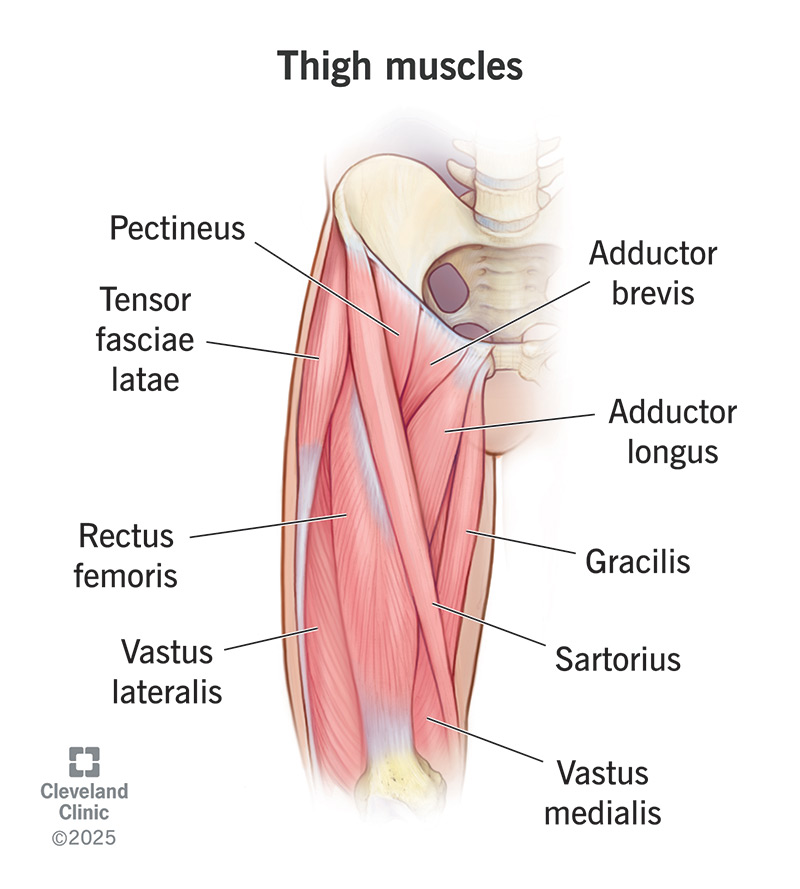Your thighs contain several different muscles that help you bend and extend your hips and knees. They also move your legs inward toward each other and let you flex and rotate your thighs at your hip joints. The muscles of your thighs are prone to injury, but there are ways to keep them healthy.
Advertisement
Cleveland Clinic is a non-profit academic medical center. Advertising on our site helps support our mission. We do not endorse non-Cleveland Clinic products or services. Policy

Your thighs contain some of the largest muscles in your body. These muscles are located on the front, back and inside of your thighs. You use them to bend, flex and rotate your lower body. Your thigh muscles also bear most of your body’s weight. They keep your hips and legs aligned and assist with balance.
Advertisement
Cleveland Clinic is a non-profit academic medical center. Advertising on our site helps support our mission. We do not endorse non-Cleveland Clinic products or services. Policy
Your thigh muscles have many important jobs. But they’re also very prone to injury, especially in athletes. Running, jumping and changing directions can put a lot of strain on the muscles of your thighs. Fortunately, there are many ways to keep your thigh muscles safe and healthy.
Each of the muscles and muscle groups in your thigh has a different job:
Advertisement
You have many different thigh muscles. They’re located in the front, back and inside of your thigh. They stretch from your hip down to your knee. Tendons attach them to bones in your pelvis, hip and knee.
The thigh muscles can be divided into three main groups, depending on their location. These groups are posterior, medial and anterior.
Posterior thigh muscles run down the back of your thigh, from your hip to just below your knee. These include your hamstrings, which are your semitendinosus, semimembranosus and biceps femoris.
Medial thigh muscles are on the inside of your thigh, starting at your pelvis and extending to your thigh bone (femur). These include your adductors, which are your adductor longus, adductor magnus adductor, gracilis and obturator externus.
Anterior thigh muscles are at the front of your thigh, starting at your pelvis and femur and extending down to your kneecap (patella) and shin bone (tibia). They include:
Your thigh muscles are skeletal muscles. They attach to bone with tendons, and they help move parts of your skeleton.
They’re made of bundles of muscle fibers containing blood vessels and nerve fibers. All of the components are held together with connective tissue.
Conditions that can affect your thigh muscles include:
Symptoms of thigh muscle conditions include:
Advertisement
Thigh muscle injuries are common in athletes due to the movements they make with their bodies. These injuries frequently affect football, soccer and basketball players.
You’re also at risk for thigh muscle injuries if you:
You can take steps to keep your thigh muscles safer and healthier, especially during physical activity:
Damage to a thigh muscle can increase the chances that you’ll injure yourself even more. Talk to a healthcare provider if you have:
Advertisement
Your thighs contain many different muscles that control movement of your hips and legs. But thigh muscle injuries, like strains and tears, are common, especially in athletes. If you have pain, numbness or weakness, or any trouble putting weight on your leg, call a healthcare provider. They can help diagnose your symptoms and recommend treatment to get you on your feet again.
Advertisement
From sudden injuries to chronic conditions, Cleveland Clinic’s orthopaedic providers can guide you through testing, treatment and beyond.

Last reviewed on 04/11/2025.
Learn more about the Health Library and our editorial process.